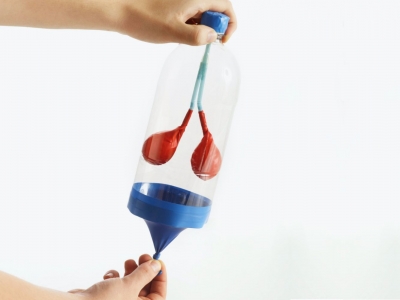
What you need:
A plastic bottle, a cutter, two balloons, a straw, modelling clay, rubber bands
What to do:
Use the cutter, under adult supervision, to chop off the bottom of the bottle.
Tie one end of one of the balloons in a knot. Snip off its other end with the scissors.
Stretch the cut end to cover the bottom of the bottle and secure it with a rubber band.
Insert one end of the straw into the mouth of the second balloon and tie it with a rubber band. Make sure air can still pass through the straw.
Push the balloon end of the straw into the bottle. Use the modelling day to completely seal the mouth of the bottle around the straw.
Now, pull on the knotted end of the balloon at the bottom of the bottle.
What happens?
Each time you pull the knot, the balloon inside the bottle inflates!
Why?
The secret is the relation between volume and pressure. Volume is the amount of space occupied by an object. In this case, our ‘object is air. Air occupies a certain space inside the bottle. No air can come in or go out as the bottle is sealed.
As a rule, when the volume of a gas increases, its pressure decreases and vice-versa. For e.g. a gas tightly compressed into a small space (small space equals less volume) has higher pressure because its molecules are all packed together and are struggling to push out. But if the gas is released and allowed to spread to a larger area (more space. more volume), its pressure falls because the molecules now have ample space.
When you pull the balloon at the bottom of the bottle, you increase the space available to the air inside the bottle. That means its pressure, falls because its volume rises.
Air tries to flow in from outside the bottle to equalize this pressure difference and the only opening it finds is the straw. So, it goes through the straw and inflates the balloon inside!
Picture Credit : Google




